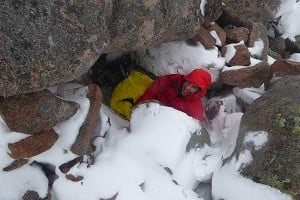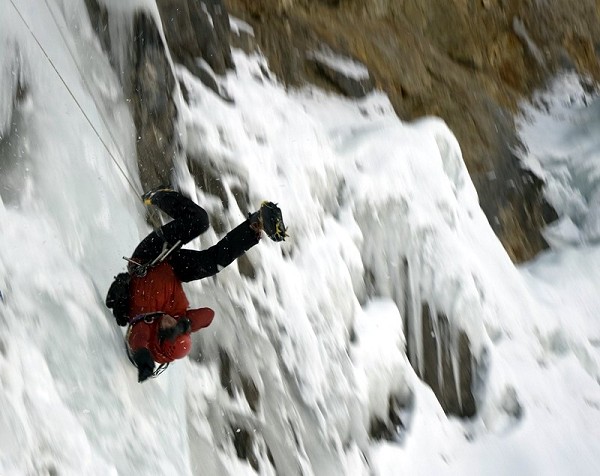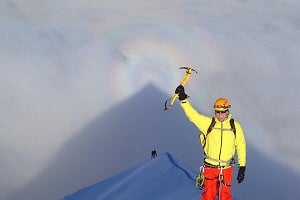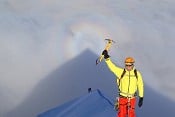

Numerous routes, unable to be scaled during the last decade because of limited ice formation, have been reborn. Unfortunately, the ensuing ice climbing frenzy has not been without its victims. The tragic deaths of Luc Avagadro and Eric Lazard are savage reminders of the dangers of this seemingly accessible mountain sport.
Both talented alpinists died when the ice pillar, La Folly (Cirque du Fer-a-Cheval), collapsed. The following day a Pyrenean guide was evacuated in a coma following an accident in the Mont Blanc massif. A week later, back at Fer-a-Cheval, the Drouillat brothers disappeared, this time on La Lyre. There cannot have been a more unpropitious start to the ice-climbing season.
When your ice season comes to a premature end following an ankle crunching, screeching fall, you are left with plenty of time to ponder the golden rule of ice:
“DO NOT FALL”
As I found myself in midair, arms flailing like a chick falling from the nest, I did not grasp the full implications of what was going on. I had no thought for the viability of the screw that I had hastily fired in five metres lower down on the route. Following hundreds of similar situations encountered when rock climbing, I switched to autopilot and waited for the twin ropes to catch my fall.
However, falls on ice and falls on rock are worlds apart. Your finely sharpened twelve point crampons are going to be your first point of contact with the ice following a rapid plunge though thin air. The huge impact always does a good job of smashing up your ankles, as the points decelerate from freefall to zero in a fraction of a second. You can then expect to find yourself flipped vertically through one hundred and eighty degrees, cracking the back of you head against a very unforgiving wall of ice.
You might notice, on impact, that those shiny axes of yours, so effective at penetrating hard ice, have speared their way into any number of your vital organs. As a bit of a bonus, your fall has also torn hundreds of pounds worth of groovy goretex to worthless shreds. Needless to say, your mates, filming the climb, have forgotten to press record on the camera and missed the whole debacle, so you will not even be able to score any glory points on Youtube. Now you just have to perform an immensely complex self-rescue and get yourself to the Docs...
Needless to say, I consider myself lucky to have escaped with ONLY a broken talus and fractured tibia of the right ankle.
Upon reflection I am convinced that my fall was a result of arrogant self-confidence... or overconfidence. My climbing partner and I had spent the first part of the day on Cigarette Russe, a one hundred and fifty metre grade five climb above La Gurraz in the Haute-Tarentaise valley. Following a ski accident in which he had damaged his knee ligaments, Luca had left me the harder pitches on the route. The ice was perfect sorbet and the climbing was featured and steep. In these ego-boosting conditions, we were soon imagining ourselves to be ice-climbing gods!
From the top of the frozen waterfall we rapped off and headed to a single pitch site at La Savinaz. I was climbing fast and efficiently but without enough regard for my axe placements. I was unconsciously climbing with a greater degree of risk, thanks to that black dog of mountaineering: overconfidence.
...I hooked a small pocket with my left axe; traversed my feet and shifted myself to the left of my tool. Had I tested the axe placement first I would have known that it was unusable and, as I traversed to the left, my axe shifted in the pocket and pulled straight out. Every one has seen the poster of the kitten hanging by a paw from a small branch with the caption; “Oh shit.” Wrap that kitten in Goretex and you start to get a good mental image of what was going on at La Savinaz that afternoon.
My right crampon hit the ice fifteen metres below, just before my ropes caught me; bending my foot to ninety degrees. By the time I had been carried to the car and driven to the local hospital my leg was looking as though it were afflicted with serious elephantiasis.
My biggest worry when ice climbing had always been the holding power and security of ice protection. Sure, the manufacturers always tell us they hold, but I have always been a tad suspicious. Because of my height on the route when I fell and the subsequent amount of rope in the system, the fall factor was relatively low, under point five. The shock was decreased yet further by using double ropes. All the same I fell a good fifteen metres, straight onto a sixteen-centimetre Simond ice screw.
After inspection, the screw showed no sign of deformation and the ice had no indications of failure. It is possible to calculate the force that the screw underwent during the fall as close to five and a half kilo newtons; approximately the same as hanging a small car from that single point. For a UIAA certificate an ice screw is required to hold fifteen kilo newtons. For a CE certification, this falls to ten kilo newtons, still twice the force I managed to create during my fifteen meter banzai.
Both Black Diamond and Petzl produce a thirteen-centimetre ice screw with a CE certificate. The shortest screw I was able to find with a ten kilo newton rating was the ten centimetre Black Diamond turbo screw. Obviously the holding power is hugely dependent on the quality of the ice and these results are a best-case scenario.
But ice screws do work!
According to these figures, my fall of fifteen metres could have easily have been held by an ice screw of ten centimetres. These forces could be massively reduced by adding shock-absorbing quickdraws into the system. Petzl claim that their Nitro absorbers can reduce the force of a fall onto a point by up to fifty percent. I will not be rushing out to recreate this and put it all to the test, but feel I have been greatly underrating the effectiveness of my equipment.
I now believe that the real danger resulting from a fall, while ice climbing, is sustaining a collision with the ice wall... and not failing ice screws.
It may be argued that it is safer to save energy by using shorter screws and placing them more often, conditions permitting, saving those twenty plus centimetre screws for the belay. This way the distance of the fall can be minimised. Logically, the shorter the fall, the less will be the speed that you will collide with the ice and the less damage which will be sustained from the resultant impact. Either way, back on the ice, I will be preaching the “DO NOT FALL” mantra loud and clear and keeping a close eye on my confidence levels.

He works for the Ecole du Ski Francais in the upper Tarentaise, where he lives. Climbing since his teenage years, Patrick is currently preparing his high mountain guide exams and climbing with the Savoie development squad. Patrick's climbing travels include the Alps of New Zealand and Thailand, amongst others.
In the French Alps Patrick continues to push his ski mountaineering and technical climbing.
















Comments